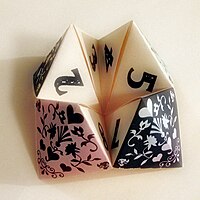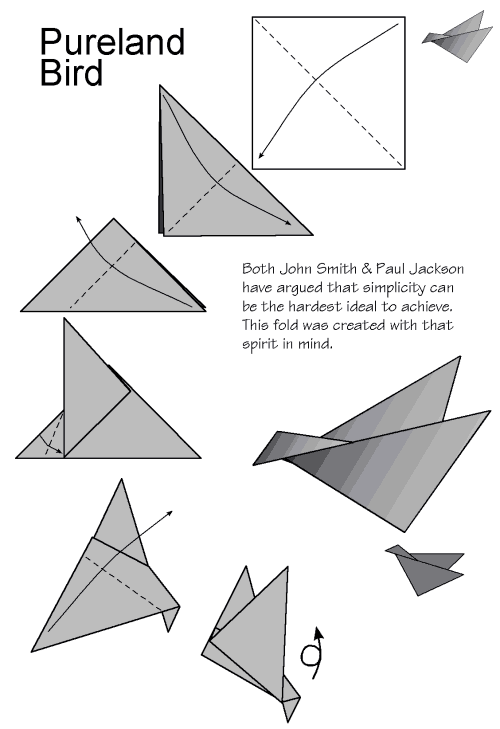Action origami is origami that creates action to the object such as Wing-flapping Birds, Paper Fortune Teller, Jumping Frog, Nodding Dog, etc. It creates objects to fly, requires inflation to complete, or uses persons' hands to change shapes.

Modular origami means putting the identical pieces together to form a complete model. Usually the complete models are symmetry. Sometimes, small pieces built an astonishing objects like the "Hello Kitty." The individual pieces can be easy to fold, but the complete object can be tricky as you can see below.


Wet-folding is a technique to create a gentle curves on the object rather than flat surfaces and folds. Use the wet paper to mold and dry the paper to keep its shape. Because they have curves, the models seem natural. For that reason, this technique is mainly used in making animal models.


Pureland origami is developed by Joh Smith in 1970s. this type of origami restricts folding and techniques: only one fold at a time, no reverse folds allowed, and all folds in straightforward locations. It is helpful for the people who are beginners in origami or who are limited in motor skills.
 Origami tessellations is growing popularity these days but already have a long history refering as far back as the Ancient Egypt. Such technique was applied on their fabric. Tessellation is the pattern of shapes arranged side by side with no gaps in between. And origami Tessellations use a piece of flat paper to fold into such patterns without any gaps. Shuzo Fujimoto have organized and published few books on origami tessellations in the late 1960's. Now, we can easily find more information about their history, their diagrams, and their application in mathematics, fashion, and science industries.
Origami tessellations is growing popularity these days but already have a long history refering as far back as the Ancient Egypt. Such technique was applied on their fabric. Tessellation is the pattern of shapes arranged side by side with no gaps in between. And origami Tessellations use a piece of flat paper to fold into such patterns without any gaps. Shuzo Fujimoto have organized and published few books on origami tessellations in the late 1960's. Now, we can easily find more information about their history, their diagrams, and their application in mathematics, fashion, and science industries.
No comments:
Post a Comment